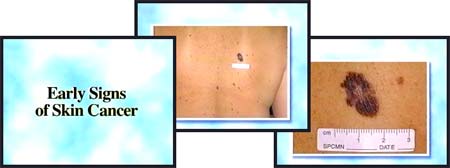
|
|
Related:
|
|
|
|
|
Skin Cancer Self-Examination
The purpose of self-examination is to assist in the early diagnosis of skin cancer.
Skin cancer can take 20 years or more to develop. Many forms grow slowly, but some melanomas may grow quickly. If found in the early stages it’s very treatable, and the way to find it early is by doing a self-exam every three to six months. 10 minutes could save your life.
Where to look:
Examine your head and face using one or two mirrors. Move your hair to examine your scalp. Have a look at your hands, including your nails. Check your elbows, arms and underarms. Look closely on your neck, chest and torso – check under your breasts if you are a woman. Using a second mirror examine the back of your neck and shoulders, as well as your upper arms, legs, back, and behind. Sit down and examine your lower legs and feet, including nails, heels, and soles. Use a small mirror to check your genitals. This should take no more than 5 or 10 minutes.
Video:

Please view a short video (22 seconds) on what Early Signs of Skin Cancer look like. The video is available in three formats:
Click the above links to open the movie in a new window, or right-click and choose "Save Target As" to save the video to a location on your computer so you can view it offline.
What to look for:
Melanomas are lesions that usually look different from other moles.
A new growth or any skin change, looking for the ABCD’s of melanoma: Asymmetry, Border irregularity, Colour change, and a Diameter greater than 5mm. Most people have freckles, birthmarks, or moles, but any irregularities or a change in the shape, edge, colour or size can be warning signs of skin cancer – if detected, see your doctor promptly:
|
Asymmetry
|
Common moles are round and symmetrical. Most early melanomas are asymmetrical. If a line divided through the middle of your mole doesn’t create equal halves then ask your doctor to have a look.
|
|
Border irregularity
|
Common moles have fairly smooth and even borders. Most early melanomas have borders that are often uneven and may have rough edges.
|
|
Color change
|
Common moles usually are a single shade of brown. Varied shades of brown, tan or black are often the first sign of melanoma. As melanomas progress, the colors red, white and blue may appear.
|
|
Diameter >5mm
|
Early melanomas tend to grow larger than common moles -- generally to at least the size of a pencil eraser (about 6mm, or 1/4 inch, in diameter). Melanomas can be diagnosed at sizes much smaller than this - the smaller the melanoma when diagnosed, the better. Lesions under 7mm have a low risk of recurrence if removed.
|
The ABCD guide for the diagnosis of melanoma has been re-evaluated. New recommendations suggest adding E for describing pigmented skin lesions that suggest cancer.
|
Evolving
|
The lesion is evolving or changing.
|
In addition to checking out the ABCDs, you should watch for these changes:
|
Size
|
The mole suddenly or continuously gets larger.
|
|
Color in Surrounding Skin
|
The skin around a mole becomes red or develops coloured blemishes or swellings.
|
|
Elevation
|
A mole that was flat or slightly elevated increases in height rapidly.
|
|
Surface
|
A smooth mole develops scaliness, erosion or oozing. Crusting, ulceration or bleeding are signs of more advanced disease.
|
|
Sensation
|
Itching is the most common early symptom - there may also be feelings of tenderness or pain. However, skin cancers are usually painless.
|
If any of these changes occur, they should be checked by a professional. It is particularly important for you to select a physician who specializes in skin cancer and is trained to recognize a melanoma at its earliest stage. You would first see a dermatologist, who might refer you to a dermatologic surgeon or oncologist (cancer specialist). Make an appointment without delay.
|